It is considered the most unpretentious, not requiring excessive care of the grower. However, the specifics of the maintenance of orchids dictates its own conditions for it, therefore, the neglect of certain requirements often leads to various diseases and death of the plant.
In most cases, the emerging problems with phalaenopsis are indicated by leaves that begin to turn yellow and wither. And if you don’t help the orchid in time, you can lose your green pet.
Fortunately, there are not so many reasons that cause a change in leaf color, and even a novice grower can easily prevent them.
Excess moisture
Excessive baying is one of the most common causes of yellow leaves on this orchid. Unlike the usual phalaenopsis, it does not need soil, all its roots are aerial. The bark, or some other substrate in which the orchid is planted, is only intended to fix the plant in an upright position. The roots themselves need a constant supply of fresh air, and the layer of water that forms on them during regular and excessive watering prevents the access of oxygen, as a result of which the roots begin to rot, cease to fulfill their main task - nourishing the leaves. As a result, the latter begin to turn yellow and die. At the same time, the leaves, still retaining their greenery, lose turgor, become soft, drooping. In advanced cases, the process of decay spreads to the stem, causing it to turn black, and the plant dies.
Finding the right watering regime to avoid root rot is not so difficult. As a rule, phalaenopsis are grown in transparent pots filled with the bark of coniferous trees. In such a container, there are no problems with monitoring the state of the roots and bark. There are several signs that indicate sufficient moisture inside the pot:
Condensation is noticeable on the walls of the pot;
- the bark is dark, pronounced wet;
- the roots pressed against the wall of the pot are green;
The pot itself is quite heavy.
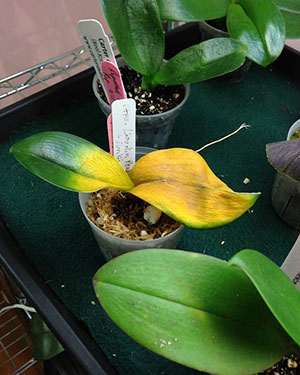
In all the cases described, watering the orchid is not required. But, in order not to be mistaken, it is recommended to remember how the roots and bark look in a dry state for comparison.
If the decay process is already in full swing, blackened roots are visible through the transparent walls of the pot, and the leaves turn yellow (sometimes black spots also appear on them), then the orchid must be removed from the planting container, thoroughly cleaned of the substrate and cut off all rotten roots and diseased leaves. . After that, the plant can be tried to reanimate. In mild cases, phalaenopsis may need to be transplanted into a fresh substrate. Watering the transplanted plant is limited, content with an increase in local humidity around its leaves, for which the base of the orchid is covered with wet, preventing it from drying out completely by regular spraying.
In severe cases, when she died most of roots, but there are still green leaves, during resuscitation one cannot do without a mini-greenhouse. And it is better not to plant the plant in the substrate, as it will interfere with the observation of the root recovery process. The orchid is fixed over sphagnum moss, or pine bark (which serve as a kind of substrate), covered with a transparent cap and placed in a bright place, protected from direct sunlight. The substrate is regularly sprayed, and the orchid leaves are wiped with a damp sponge.
Too much light
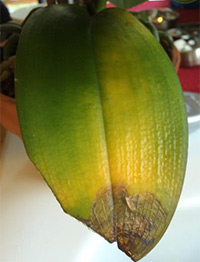
Phalaenopsis is a shade-loving plant that feels comfortable even at some distance from the window. It does not tolerate bright light, especially direct sunlight, which causes leaf scorch. Three degrees of damage to the leaf plate can be distinguished:
With an excess of illumination, a thin yellow border appears on several sheet plates at once;
- with weak exposure to the sun, peculiar “potholes” are formed on the sheet - areas of merging, as if pressed yellowish spots;
- prolonged exposure to the sun causes the appearance of large shapeless yellow burn spots, in especially severe cases bordering on brown filmy bald spots of completely burned tissue.
If the lesion is local in nature, then the orchid can simply be moved to a more suitable place for it or shaded. A damaged leaf can be cut off or wait for the phalaenopsis to drop it. In the case of prolonged exposure to the sun and yellowing of most of the leaves, attention should be paid to the condition of the stem and roots. If they are elastic, green, then there is a chance to save the orchid by rearranging it in the shade and increasing the local humidity (without watering). With dried roots and a yellowed stem, there is no chance to reanimate the plant.
Growth point damage
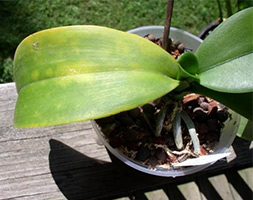
Phalaenopsis is an orchid with a monopodial growth pattern, that is, it has a single, unbranched, constantly growing stem. If the growth point (the top of this stem) is damaged, the orchid may die. This process begins with yellowing of the upper leaves and then spreads down the stem to the base. But, as a rule, such a scenario for phalaenopsis is very rare and is associated not with mechanical damage to the top of the plant, but with its decay. It is more likely that the growth of the main stem will stop with the further appearance of a basal baby. It is on her that the orchid later transfers its development.
natural causes
For Phalaenopsis, the annual loss of one of the lowest leaves is the norm. This is a natural process associated with the life cycle. It begins with yellowing of the leaf plate, which gradually becomes bright yellow, then wrinkles, turns brown and falls off.
They delight us with their riot of colors, but sometimes they too. In popular varieties, for example, the leaves may turn yellow.
In this article, we will try to understand why this happens.
natural process
Seeing that the leaves of the orchid began to turn yellow, do not panic. This is how it manifests natural aging process Each leaf has its own cycle. Such a "change of generations" is characteristic of all colors.
In mass hybrids (cattleya,) one bottom sheet dries out. Less often, two processes die. In the genus nobile, all the leaves can fall from the bulb, both with and with the living.  If it is visible that only the lower leaves of the orchid turn yellow, do not rush to do something. The sheet will dry completely and separate by itself. It is not necessary to trim or pluck the barely yellow shoots so as not to injure the plant once again.
If it is visible that only the lower leaves of the orchid turn yellow, do not rush to do something. The sheet will dry completely and separate by itself. It is not necessary to trim or pluck the barely yellow shoots so as not to injure the plant once again.
Important! Check your plants regularly. Yellowing can occur very quickly, within 1-4 days.
The age of the flowers also affects - the foliage rarely remains viable for several years. Shedding of leaves each year (during flowering or dormancy) is normal for this species. With proper care, flower growers are rarely worried about why the leaves of an orchid turn yellow. If there were any omissions, then the plant immediately reacts to them, changing color or slowing down in development.
Irrigation violation
One of the main reasons is non-compliance with the irrigation regime. They forgot on time or, on the contrary, waterlogged the soil - this disrupts the metabolism. Because of such blunders, a “hazing” color of the leaves appears.
Did you know? Some orchids are able to live underground.
Insufficient watering
Such cases are rare, but anything can happen. Let's take the same phalaenopsis. Outwardly healthy stem, normal roots, and leaves give off yellowness. This is possible even with regular watering. 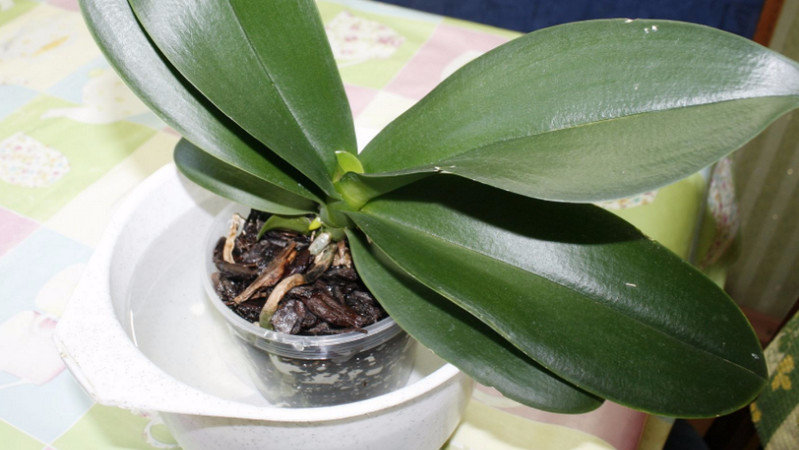 The matter may be humidification method- supplying water from a watering can, thereby poorly moisturizing the bark (a good one quickly removes moisture into the pan, preventing the roots from “getting drunk”). Nutrients become deficient, and young shoots, as it were, intercept them from old ones. As a result, it becomes unclear why they turn yellow, and what to do.
The matter may be humidification method- supplying water from a watering can, thereby poorly moisturizing the bark (a good one quickly removes moisture into the pan, preventing the roots from “getting drunk”). Nutrients become deficient, and young shoots, as it were, intercept them from old ones. As a result, it becomes unclear why they turn yellow, and what to do.
Everything is simple. Switch to the so-called immersion watering to avoid instant waterlogging. Within a week or two after changing the regime, the plant will return to normal.
Too much moisture
The most common cause of leaf diseases. Beginners often "flood" the orchid. The harm from frequent water procedures is obvious - here is “clogged”, lifeless soil, and decay, accompanied by bacteria.
Experienced flower growers are advised to focus not only on upper pieces of bark. They dry quickly, literally in a day, and at a depth the substrate will retain moisture longer. Keep this in mind when starting watering.
Diseases that cause yellowing of leaves
The leaves of the orchid also turn yellow and fall due to the presence of infections. A fungal, viral or bacterial disease can get a flower from a diseased plant. They are isolated from normal plants.
Fungal infections affect the plant due to an oversight of the owners. The main symptom is dark yellow round spots on the leaf or stems.  With such diseases, tubercles appear, they are mycelium. While there are few of them, processing will help. Advanced cases are treated with radical methods: pruning the diseased area or the entire sheet. During treatment, the tubercles themselves cannot be cut, otherwise the spores will be carried to other flowers. The cut site is treated.
With such diseases, tubercles appear, they are mycelium. While there are few of them, processing will help. Advanced cases are treated with radical methods: pruning the diseased area or the entire sheet. During treatment, the tubercles themselves cannot be cut, otherwise the spores will be carried to other flowers. The cut site is treated.
Main types:
- gray rot (treated by "Immunocytophyte");
- powdery mildew (“an antidote” is a solution of colloidal sulfur. A couple of hours before spraying, the soil is filled with water);
- anthracnose, which is treated with Mikosan.
Important! The fungus mainly affects orchids of Asian lines. For plants from Southeast Asia, such diseases in a mild form do not pose a particular danger.
In case of viruses the matter is even more serious. They appear during a period of stress (transportation of a flower, sudden changes in temperature, change in humidity regime). The risk of infection of other orchids increases during watering. Then the leaves become covered with dark rings, but there may be other signs.
If suspected, the flower is treated with an antibiotic and fungicidal agents. Unfortunately, such measures may not have an effect, but these ailments are rare.
Bacterial spotting attack old leaves. They become soft, yellowish with a dark tint appears. Visible sores that secrete fluid.
The treatment is simple: the problematic segment is cut off, and the incision is treated with iodine.
The use of tap water can result in chlorine saturation of the soil. To save the plant, water it with filtered water.
Now we know how to save an orchid if the leaves turn yellow. We hope that our readers will not have to face these symptoms, although this article will certainly be useful to them.
Was this article helpful?
Not really
The Phalaenopsis orchid is very popular with flower growers involved in indoor cultivation of these incredibly beautiful and unpretentious plants. It is the photo of "Phalaenopsis" that is most often found on the forums of amateur flower growers. It should be remembered that some types of orchids require significant effort in the implementation of care activities. However, this does not apply to Phalaenopsis orchids. Growing such a plant is easy even for beginner growers. Often, beginners in floriculture are concerned about why yellowness appears on the leaves of the phalaenopsis orchid, what should be done in this case. Even despite the absolute unpretentiousness, such a variety of orchids as Phalaenopsis can be weakened as a result of significant violations that accompany the cultivation and care of this houseplant.
Latest articles about gardening and gardening
Factors affecting the yellowing of the leaves of the Phalaenopsis orchid
There can be several factors that contribute to the yellowing of leaves on orchids, and they are extremely diverse. The main experts include improper watering, insufficient or malnutrition of the plant, various types of diseases and pests, as well as the irrational use of mineral types of fertilizers and dressings.
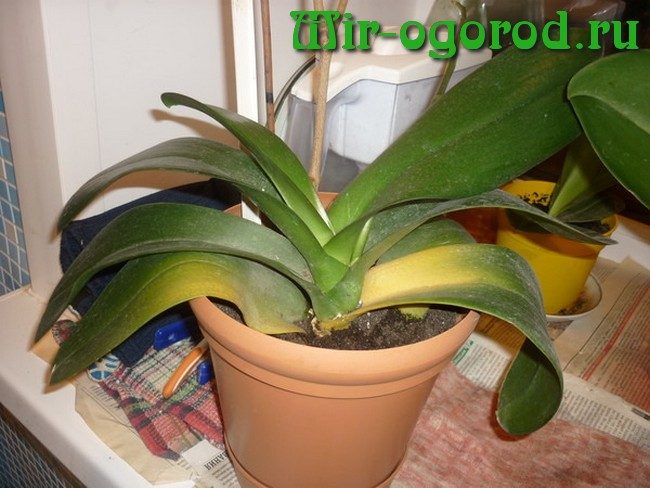
Phalaenopsis orchid leaves turn yellow due to the natural aging process of the leaves
If you have one bottom leaf turned yellow and completely dry (in rare cases, two bottom leaves) in such orchids as phalaenopsis, while other leaves retain their color, then there is no reason to worry: each orchid leaf goes through its life cycle. The plant gives birth to new leaves, old leaves die - there is a natural change of leaves. In a dendrobium nobile orchid (noble dendrobium), the upper leaves of the bulb, which has already faded, may turn yellow. In addition, the dendrobium nobile can also shed all the leaves from a faded or blooming bulb. If you see that the yellowing of orchid leaves is due to the natural process of leaf aging, then no special action needs to be taken - you just need to let this leaf dry completely, and it will separate from the plant. After that, the dry leaf can be removed. There is no need to cut or tear off the yellowing orchid leaf on your own. First of all, the plant begins to turn yellow due to the natural shedding of leaves. If one leaf has turned yellow or dried up, and the rest are in the same state, then, as a rule, you should not worry, this means that the life cycle of this leaf has simply ended and a new one will soon form in its place.
Phalaenopsis orchid leaves turn yellow due to frostbite
In phalaenopsis, sluggish yellow leaves indicate frostbite. At the same time, the leaf plate loses turgor without any visible mechanical damage and painful spots. For an orchid, transportation without protection through cold air in winter or keeping near a window is fatal, where the air temperature often drops below + 15 degrees. Frostbite leaves lose elasticity, become dark green and watery. Treatment: the affected parts of the plant must be removed to healthy tissue. Dead tissues are a favorable environment for the propagation of a variety of rot. Make cuts with a sharp blade. Places of cuts are sprinkled with crushed, activated carbon. In addition, you need to carefully examine the flower, whether there are black spots on its stem or other parts. A frozen plant is not transplanted. This is an additional injury that can lead to death.
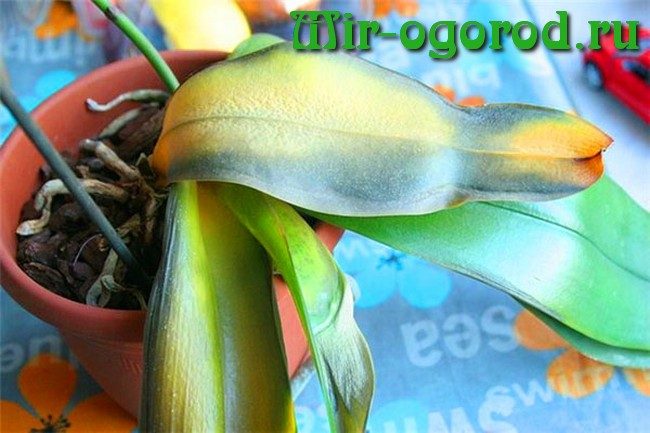
Phalaenopsis orchid leaves turn yellow due to a fungal disease
Phalaenopsis orchids are sensitive to stagnant water and prone to fungal diseases. Orchids pick up fungal infections very easily in the store. If you recently bought a new phalaenopsis (cattleya, cumbria or other orchid) and it suddenly began to turn yellow leaves after the purchase, you can not look for other reasons. Start treatment right away. The faster you react, the better the plant's chances of survival. Yellowing can also occur due to a bacterial or viral infection, but such cases are still rare. But to treat them is much more difficult, and sometimes completely impossible.
Pest Control Articles
If the leaf on your orchid has already turned yellow, it is impossible to bring it back to life. In addition, you need to clearly understand that if the orchid turns yellow on the leaf, then the problems are not only with the leaf. It is useless to cut off the leaf or its yellowed part. The fungus sits inside the stem or rhizome, so the whole orchid must be treated. Otherwise, the first sheet will be followed by yellowing of the next. Fungus needs water to live. Therefore, in order to cope with the fungus, you must first dry the orchid well. Whole, wholly and completely. Both leaves and roots and stem (in sympoidal rhizomes). This will greatly slow down the progress of the infection. Unfortunately, in many cases, drying is not enough to completely cope with the disease. The infection may subside for a while and go full steam ahead as soon as you start watering the orchid in the usual way. Therefore, along with drying, it is necessary to treat the orch with antifungal drugs (fungicides).
Phalaenopsis orchid leaves turn yellow due to improper watering
The state of the roots is connected with a thin thread with the color of the foliage. Due to the constant overflow, the foliage can lose turgor, become soft and turn yellow. They may also develop wet patches.
Treatment: in this case, a transplant into a new substrate is necessary.
If the phalaenopsis looks healthy, the root system is without signs of damage, but the lower leaves turn yellow, which means that the earthen lump is too dry. You water the plant regularly, but it continues to turn yellow, pay attention to the watering method. Most likely, you are doing classic watering with a watering can. In this case, the water does not have time to moisten the bark and immediately falls into the pan, and the roots do not have time to drink, they have nowhere to get water from. The result is nutritional deficiencies. To compensate for this deficiency, the plant will begin to extract water and nutrients from the oldest leaves, causing them to begin to turn yellow.
Treatment: Give preference to immersion watering and you will avoid similar problems in the future.
![]()
Phalaenopsis orchids turn yellow leaves due to watering with hard water
Many cannot understand why phalaenopsis leaves turn yellow. In most cases, the reason is very commonplace - hard water has a bad effect on the base, buds and the entire orchid as a whole. If you constantly water your pet with hard water, this will lead to salinization of the earthy coma. As a result, iron will no longer be absorbed and functional chlorosis will develop (first, the bottom sheet, and then all the others, will be covered with yellow spots, and after a while they will begin to fall off).
Treatment: transplant the plant into fresh soil. Carry out foliar top dressing: wash the foliage with liquid fertilizers (Pocon, Bona Forte). Be careful: if the orchid is in bloom, do not disturb it and transplant it. It will be enough to free the bark (substrate) from salts by watering it with distilled water. Remember that distilled water can only be used diluted with tap water in a ratio of 1:1. In a few months, following my advice, the yellowed phalaenopsis leaves will fall off, and new and healthy ones will appear in their place.

Phalaenopsis orchids turn yellow leaves due to sunlight
Sometimes with a long exposure to direct sunlight on the leaves of the phalaenopsis orchid, individual sections of the leaves turn yellow. In this case, the leaf does not turn yellow completely, but only those areas that have been exposed to the aggressive effects of the sun. Just move the orchid to partial shade and see the improvements.
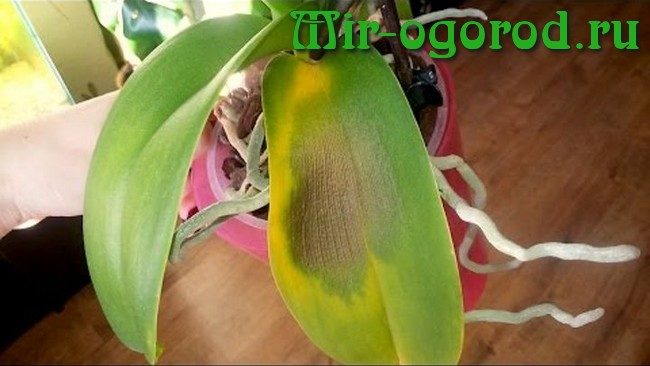
Transplanting and fertilizing phalaenopsis orchids
Phalaenopsis is a plant that does not like transplanting and practically does not need it. The only situation when you need to transplant an orchid is active growth and small pot sizes. This can be understood by the number of roots that have begun to grow outside the pot: the more there are, the sooner a new one will be needed - a larger one. It is important to transplant the plant into the same transparent plastic container, replacing the substrate. As for feeding the orchid, this can be done once a year, in early spring, to stimulate the exit from the dormant stage and the active growth of the flower. It is important to purchase special fertilizers, a universal product is not suitable for phalaenopsis.

Thus, the yellowing of the leaves and peduncle of the Phalaenopsis orchid is most often a normal physiological process of plant growth, but in some cases it should cause concern for the grower. Having noticed the first signs, you need to immediately respond to the symptoms and provide the orchid with the necessary conditions for comfortable growth. It is important to know the rules and requirements for growing phalaenopsis so that they grow healthy and beautiful. An orchid is a whimsical flower, but if desired, the conditions for caring for it are easily observed. Then it will grow, bloom and delight with its appearance.
What to do if the leaves of the Phalaenopsis orchid turn yellow
A sign of a lack of sunlight is not only stretching of the shoots, but a change in the color of the leaves from rich green to yellow. Moreover, the reaction of the flower is both gradual and abrupt, up to the fall of the lower leaf plates. To prevent the situation when the leaves of the orchid turn yellow, you need to find a suitable place for the flower, and provide artificial lighting in winter.
Most types of orchids need long daylight hours, but not in direct sunlight. With an excess of bright light, the orchid leaves turn yellow, covered with drying burn spots.
Orchid leaves turn yellow due to hard water and excess fertilizer.
 Excessive salt content in irrigation water adversely affects the entire plant, but the leaves are the first to signal a change in conditions and poor health. Sometimes it is difficult to determine the reason why the orchid leaves turn yellow. A kind of clue can be the appearance of the substrate and the pot. If traces of salt deposits are visible on them in the form of whitish streaks and plaque, an explanation for yellowness has been found.
Excessive salt content in irrigation water adversely affects the entire plant, but the leaves are the first to signal a change in conditions and poor health. Sometimes it is difficult to determine the reason why the orchid leaves turn yellow. A kind of clue can be the appearance of the substrate and the pot. If traces of salt deposits are visible on them in the form of whitish streaks and plaque, an explanation for yellowness has been found.
Hard water provokes the development of chlorosis. The leaves of the orchid turn yellow, only the veins remain green. Then the shoots are exposed, and the plant may die.
You can save a flower with the help of transplantation and well-conducted foliar feeding, for which only specialized formulations are used.
A blooming orchid should not be transplanted, but it will be very useful to carry out repeated washing of the substrate with a mixture of distilled and ordinary settled water. The same washing method is used to treat an orchid that has suffered from excess fertilizer or the use of an unsuitable, unbalanced composition for feeding.
 What other reasons cause a change in the color of the foliage? Why do orchids turn yellow leaves? There are really many factors pushing a plant to such behavior. This may be a natural reaction to a change of scenery, such as after a purchase or as a result of seasonal changes unnoticed by the owner.
What other reasons cause a change in the color of the foliage? Why do orchids turn yellow leaves? There are really many factors pushing a plant to such behavior. This may be a natural reaction to a change of scenery, such as after a purchase or as a result of seasonal changes unnoticed by the owner.
The leaves of an orchid turn yellow if the pot in which the flower is located has long been small for him. In this case, the plant is carefully transferred to a larger container.
Orchid pest infections
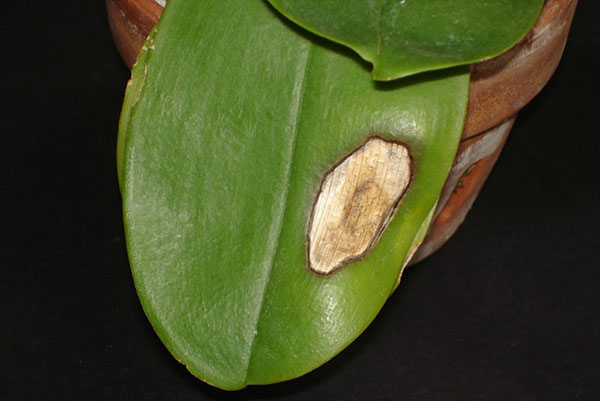 Regular waterlogging of the substrate is doubly dangerous for orchids, as it is fraught with the development of not only putrefactive, but also fungal infections. A weakened plant attracts mites and pests.
Regular waterlogging of the substrate is doubly dangerous for orchids, as it is fraught with the development of not only putrefactive, but also fungal infections. A weakened plant attracts mites and pests.
With the timely detection of a problem, when the orchid leaves turn yellow and wither, but the root system is still viable, after sanitization and irrigation with a fungicide, the flower is transplanted into a new soil. Unfortunately, the infection spreads rapidly and can quickly lead to the death of an adult flowering specimen.
In dry air, indoor orchids are attacked by spider and root mites. Pests infect shoots, rhizomes and leaf plates, causing the leaves to turn yellow in the orchid, and the plant itself is seriously weakened due to lack of nutrition.
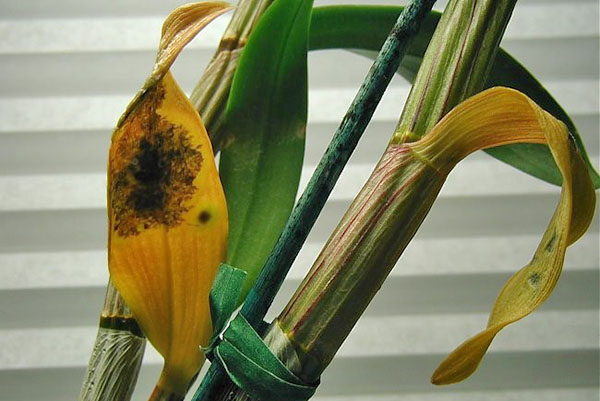 If timely treatment with acaricidal preparations is not carried out, the flower loses adult foliage, and the growth of a new one slows down. In the presence of soil pests, you should not be limited to spraying, it is much more effective to combine this procedure with a transplant.
If timely treatment with acaricidal preparations is not carried out, the flower loses adult foliage, and the growth of a new one slows down. In the presence of soil pests, you should not be limited to spraying, it is much more effective to combine this procedure with a transplant.
Video about the causes of yellowing orchid leaves


